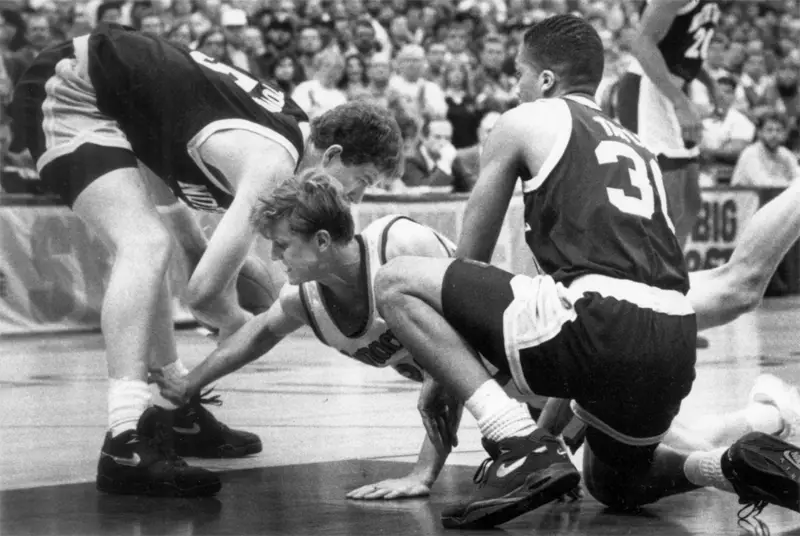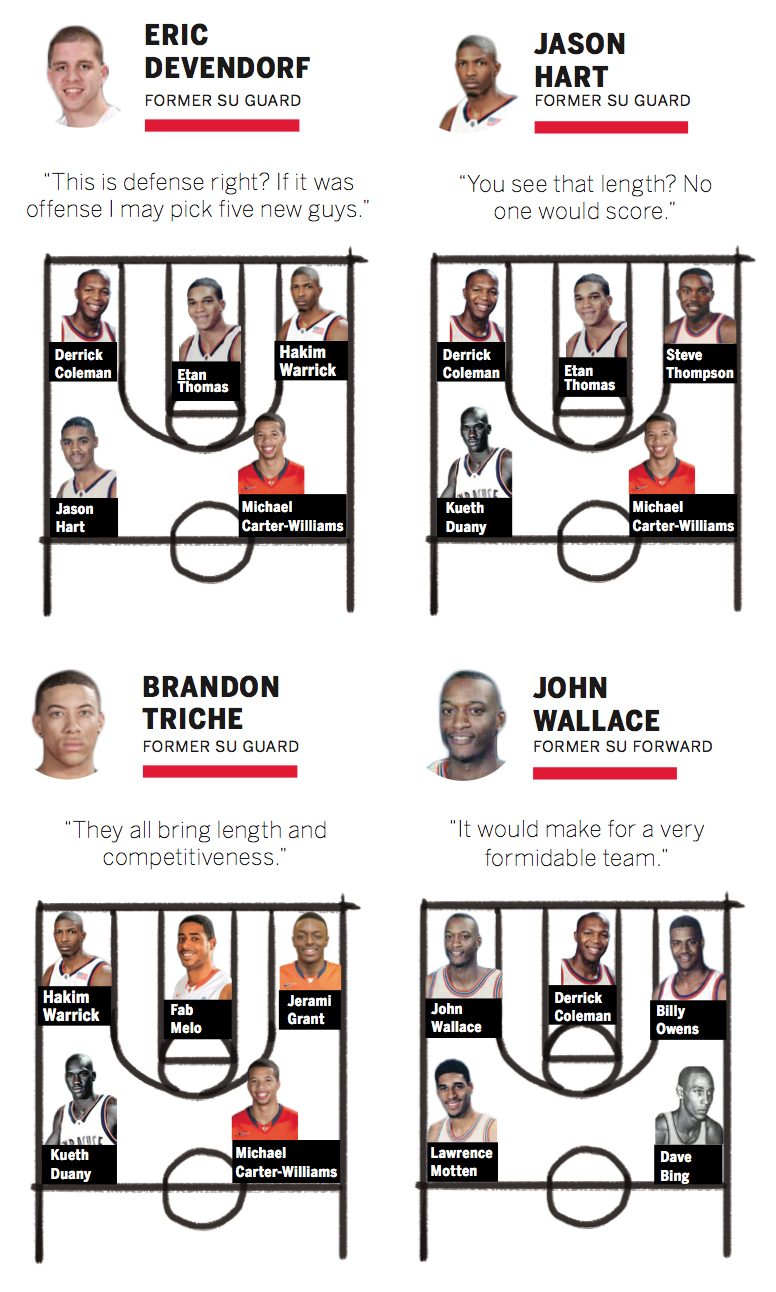Every time Andrew Kouwe caught the ball on the wing in practice, he knew where to look for a shot — right over his roommate, Hakim Warrick.
The Syracuse sophomore forward was often late rotating to the corner during the 2002-03 season.
“Hakim sometimes wasn’t the best defender in the back of the zone,” the walk-on Kouwe said. “Sometimes he would get a little bit lazy coming out on the shooters.”
“Read the play,” Jim Boeheim would tell Warrick. “Don’t react.”
They drilled it every day until Warrick’s slides became second nature.
And when the time came for his final test — a swing pass from Kirk Hinrich to Michael Lee with three seconds left in the national championship game — Warrick sprung toward the corner, leapt and blocked the potentially game-tying attempt out of bounds, sealing the first and only national championship in Syracuse history.
“If he had just reacted, he might not have gotten there in time,” Kouwe said. “But the fact that he was able to read, not react, is how he was able to get that block.”
Once Boeheim went almost exclusively to the zone around 1996, he used the extra time for coaching the intricacies of his defense and establishing a staff suited to recruit to his system. The players that once varied in size and shape grew to look more familiar each year. They became cogs in his machine.
Stocky, muscular guards who could fight over screens. Long, springy wings with arms that went on forever. And centers who could protect the rim and run the floor.
Boeheim sought players with specific traits — not just the McDonald’s All-Americans that regularly filled rosters in Kentucky, Kansas, Duke and North Carolina. Smart players. Perceptive players. Deceptive players. He built a perennial top 10 program with only two one-and-done players ever and four active NBA players today.
This season, with the new hand-checking rules leading to more zone use than ever across the country, Boeheim’s nearly 17 seasons of running near-total zone have put him miles ahead of the national landscape.
“It’s a big disparity,” former Providence head coach Pete Gillen said. “A lot of zones are like Swiss cheese. They’ve got a lot of holes, a ‘Hands Up, Harry’ kind of zone.”
Starters from Syracuse 2-3 Zone Teams
| Season | Point Guard | Shooting Guard | Small Forward | Power Forward | Center |
|---|---|---|---|---|---|
| 1996 – 1997 | Jason Hart | Jason Cipolla | Marius Janulis | Todd Burgan | Otis Hill |
| 1997 – 1998 | Marius Janulis | Todd Burgan | Ryan Blackwell | Etan Thomas | |
| 1998 – 1999 | Allen Griffin | Damone Brown | |||
| 1999 – 2000 | Tony Bland | ||||
| 2000 – 2001 | Allen Griffin | DeShaun Williams | Preston Shumpert | Damone Brown | Jeremy McNeil |
| 2001 – 2002 | DeShaun Williams | Kueth Duany | Hakim Warrick | Craig Forth | |
| 2002 – 2003 | Gerry McNamara | Carmelo Anthony | |||
| 2003 – 2004 | Billy Edelin | Josh Pace | |||
| 2004 – 2005 | Louis McCroskey | ||||
| 2005 – 2006 | Eric Devendorf | Demetris Nichols | Terrence Roberts | Darryl Watkins | |
| 2006 – 2007 | Josh Wright | ||||
| 2007 – 2008 | Jonny Flynn | Paul Harris | Kristof Ongenaet | Donté Greene | Arinze Onuaku |
| 2008 – 2009 | Eric Devendorf | Paul Harris | Rick Jackson | ||
| 2009 – 2010 | Brandon Triche | Andy Rautins | Wesley Johnson | ||
| 2010 – 2011 | Scoop Jardine | Brandon Triche | Kris Joseph | Fab Melo | |
| 2011 – 2012 | Rakeem Christmas | ||||
| 2012 – 2013 | Michael Carter-Williams | C.J. Fair | DaJuan Coleman | ||
| 2013 – 2014 | Tyler Ennis | Trevor Cooney | Jerami Grant | Rakeem Christmas |
Through the 1960s, ‘70s and ‘80s, Boeheim was introduced to most of the ways an opponent could attack the zone.
Villanova’s Rollie Massimino attacked the short corner. Georgetown’s John Thompson Jr. used movement to open the high post. Gillen and Louisville’s Denny Crum screened the weak-side guard.
Now Boeheim has seen just about everything. It’s the opponents that are unable to prepare, because his zone is impossible to replicate in a practice.
“It’s much like when Georgetown had Patrick Ewing,” Boeheim said. “You could practice against their 2-3, 1-3-1, anything you wanted, but at the end of the day when you made your play and made your move and you went to shoot it, he blocked it.”
While the rest of the nation scrambles to prepare for Syracuse each game, Boeheim puts his players through the same slides and rotations every day in practice.
He uses drills to emphasize immediate opponents’ strengths, but it’s the mechanic nature of the unit that makes the Orange so lethal come NCAA Tournament time each year.
It’s a nightmare. I think people psychologically have a problem with it before they even play him. It’s points in the book, just the mental preparation other teams need before playing it.
Dick Vitale, ESPN analyst
In building that, Boeheim has employed a staff that understands just the type of players he wants.
Lead assistant Mike Hopkins was once a four-year hard worker who became a senior captain at SU in 1993. Adrian Autry was a four-year starting point guard who came through one year after Hopkins did. And only recently, Gerry McNamara was the tough-minded, intelligent point guard that helped lead Warrick and Co. to the 2003 national championship.

File Photo
They’ve brought in the Scoop Jardines and Eric Devendorfs to the backcourt and Arinze Onuakus and Rick Jacksons to the frontcourt — guys who’ve maximized their talent while hiding their potential defensive inadequacies in the zone.
Carmelo Anthony (2003) and Donte Greene (2006) are the only players who’ve left Boeheim for the NBA as freshmen.
“I don’t doubt that they could get more one-and-dones if they wanted,” said ESPN analyst Fran Fraschilla, a former St. John’s head coach, “but they have success getting guys that stick around awhile, which makes the zone even better because guys then learn the nuances of the zone.”
Each year, the screws of the zone seem to tighten a bit more. The guards pump up an extra few pounds and the wings shorten time drops by a couple milliseconds.
The Orange consistently ranks among the best in the country in most defensive categories. This year’s squad is sixth in scoring defense, seventh in steals per game — led by Tyler Ennis and Trevor Cooney who sit one-two atop the Atlantic Coast Conference in that category — and eighth in fouls per game.
“Now that I think I’ve got everything down, it’s one of the craziest things,” Ennis said of the zone. “Just thinking about it and the ways of it is just genius.”

Sam Maller | Photo Editor
And it’s not a bad time to be coached by a genius. The popularity of the zone has escalated this season, in part due to the new hand-checking rules.
“In the nonconference schedule, we’ve faced more zone in that period of time than probably any full season,” Duke head coach Mike Krzyzewski said.
Unfortunately for the rest of the nation, the Orange is a world ahead.
It’s prepared to adjust to anything — whether that be the way fouls are being called or the way an opponent is attacking its zone.
On Jan. 6, Notre Dame head coach Mike Brey said the way to beat Syracuse’s zone is to have a shooter catch fire from the outside.
One week later, Boston College guard Lonnie Jackson shot 6-of-9 from long range as the Eagles put SU on its heels.
Boeheim extended his guards. The Eagles turned to Ryan Anderson in the high post.
The Syracuse wings clamped down to help Baye Moussa Keita in the paint. Boston College tried screening the outside guards to rekindle the 3-point game.
But BC managed just eight points over the final 10:09. The Eagles lost the chess match. The zone finally caught up to them.
That’s what Boeheim does every game. Examine and adjust. That’s what he’s been able to do since switching to the zone almost exclusively about 17 years ago.
While other coaches fluster and fret, Boeheim sticks to his bread and butter.
The wheel that he’s put in motion continues to rotate.
At this point it all but moves itself.
Dream Teams
With access to any player in Syracuse history, these four stars selected their all-zone teams.

Published on January 29, 2014 at 4:54 am
Contact Stephen: [email protected] | @Stephen_Bailey1

